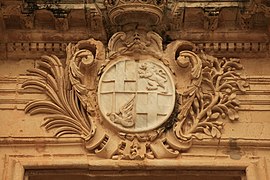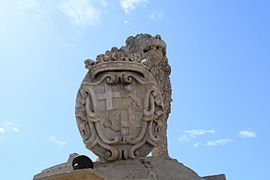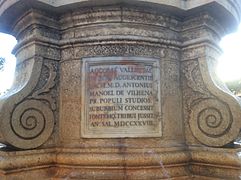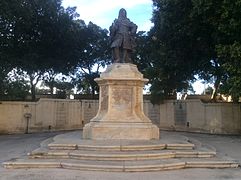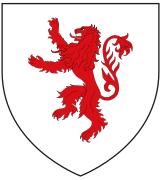António Manoel de Vilhena
António Manoel de Vilhena | |
|---|---|
Ramon Despuig | |
| Personal details | |
| Born | 28 May 1663 St. John's Co-Cathedral |
| Military service | |
| Allegiance | |
António Manoel de Vilhena (28 May 1663 – 10 December 1736) was a
Early life
António Manoel de Vilhena was born in
Magistracy
De Vilhena was elected Grand Master on 19 June 1722, three days after the death of his predecessor

In 1723, Vilhena financed the construction of Fort Manoel on the Isolotto (now Manoel Island after the Grand Master) in Marsamxett Harbour. The fort was completed ten years later, and it remained in use until the 20th century. Its chapel was dedicated to St. Anthony of Padua, the patron saint of the Grand Master. Vilhena also set up the Manoel Foundation in order to maintain and garrison the fort and its outworks. A bronze statue of the Grand Master was installed in the fort's piazza in 1736, and it was relocated a number of times before being placed in its present location at Pope John XXIII Square in Floriana.[5]
Apart from the construction of Fort Manoel and the restoration of Mdina's walls, a number of improvements were made to the fortifications of Malta throughout Vilhena's magistracy. Saint Anthony's Battery was built on Gozo, the fortifications of Birgu were strengthened, and work continued on the unfinished Cottonera Lines. In 1736, the Santa Margherita Lines were finally completed nearly a century after construction had begun.[2]

In 1724, the Grand Master founded a suburb called Borgo Vilhena in order to meet the demand for housing within the capital Valletta. The suburb was built in the area between the newly completed Floriana Lines and the Valletta Land Front.[6] The town is now known as Floriana,[7] and it retains symbols from Vilhena's coat of arms in its emblem.[8]
In 1730, Vilhena built a summer residence named Palazzo Manoel (now known as Casa Leoni) in Santa Venera.[9] He also built a hunting lodge in Naxxar in 1733, which was later converted into Palazzo Parisio.[10] Vilhena also embellished the 16th-century Verdala Palace in Buskett.[11]
Vilhena also ordered the construction of the Teatro Pubblico in Valletta in 1731. The theatre opened a year later, and it was renamed Manoel Theatre in the 19th century. It is still in operation today.[12] Another public building constructed during Vilhena's magistracy is the Banca Giuratale of Gozo, which was built in 1733.[13]
Vilhena's magistracy was marked by the only attempt to end the
Death
Vilhena died on 10 (or 12
Fort Manoel is supposedly haunted by a ghost known as the Black Knight, who resembles de Vilhena.[16]
Heraldry
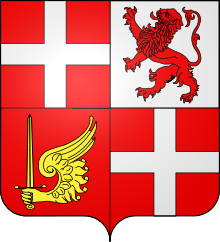
Vilhena's coat of arms consists of a lion and a winged arm holding a sword representing the House of Manuel de Villena, quartered with a white cross on a red background representing the Order of St. John. The blazon is per fess Argent a lion Gules the head Or and Gules a winged arm clothed with a maniple Or holding a sword Argent.[8]
The Grand Master's coat of arms can be seen in many buildings commissioned by him, such as
-
Grand Master's Palace, Valletta (fresco)
-
Palazzo Vilhena, Mdina
-
Lion Fountain, Floriana
-
Inscription below lion
-
Cannon at the Palace Armoury, Valletta
Motifs from his coat of arms are still used today in the coat of arms of Floriana:[8]
-
Coat of arms of Floriana 1993–2006
-
Coat of arms of Floriana since 2006
References
- ^ "Manoel Vilhena" (PDF). Lehen is-Sewwa (in Maltese). 26 August 1972 – via University of Malta.
- ^ a b c Zammit, Vincent (1992). Il-Gran Mastri – Ġabra ta' Tagħrif dwar l-Istorja ta' Malta fi Żmienhom – It-Tieni Volum 1680–1798 (in Maltese). Valletta: Valletta Publishing & Promotion Co. Ltd. pp. 368–386.
- ^ De Lucca, Denis (1979). "Mdina: Baroque town planning in 18th century Mdina". Heritage: An Encyclopedia of Maltese Culture and Civilization. 1. Midsea Books Ltd: 21–25.
- ^ De Lucca, Denis (1979). "Mdina: Mondion's master plan for the old city". Heritage: An Encyclopedia of Maltese Culture and Civilization. 1. Midsea Books Ltd: 53–56.
- ^ Spiteri, Stephen C. (2014). "Fort Manoel". ARX Occasional Papers. 4. Retrieved 27 November 2015.
- ISBN 9781841624525.
- ^ "Introduction". Floriana Local Council. Archived from the original on 8 October 2015.
- ^ a b c "Sovereign Military Order of Malta – Grandmaster Antonio Manoel de Vilhena". Flags Of The World. Archived from the original on 8 October 2015.
- ^ "Palazzo Manuel" (PDF). National Inventory of the Cultural Property of the Maltese Islands. 28 December 2012. Archived from the original (PDF) on 20 November 2015. Retrieved 27 November 2015.
- ^ "One World – Protecting the most significant buildings, monuments and features of the Maltese islands (10)". Times of Malta. 20 June 2009. Archived from the original on 3 October 2015. Retrieved 27 November 2015.
- ^ Graham, Jimmy (27 February 2014). "Verdala Palace". Le Crac. Archived from the original on 27 November 2015.
- ^ Denaro, Victor F. (1960). "The Manoel Theatre" (PDF). Melita Historica. 3 (1): 1–4.
- ^ "HSBC Malta Foundation sponsors Banca Giuratale restoration". Times of Malta. 20 July 2014. Archived from the original on 27 November 2015.
- ^ UOM Archived 2 October 2020 at the Wayback Machine.p. 14.
- ^ "The Chapel of the Langue of Castile, Leon and Portugal". stjohnscocathedral.com. Archived from the original on 19 September 2015.
- ISBN 9990900302.


